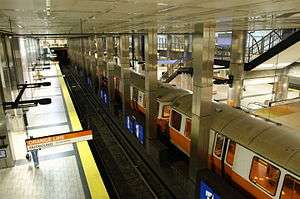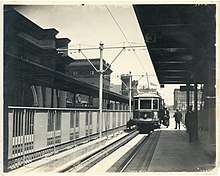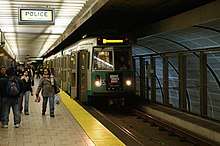North Station (subway)
North Station is an underground MBTA subway station in Boston, Massachusetts. Served by the Massachusetts Bay Transit Authority (MBTA) Green Line and Orange Line, it is connected to the North Station surface terminal used by MBTA Commuter Rail and Amtrak. The station is fully accessible. From May 24, 2020, to April 2021, North Station is temporarily the northern terminus of Green Line service due to Green Line Extension construction.
North Station | |||||||||||||||||||||||||||||||||
|---|---|---|---|---|---|---|---|---|---|---|---|---|---|---|---|---|---|---|---|---|---|---|---|---|---|---|---|---|---|---|---|---|---|
 A southbound Orange Line train at North Station in 2006 | |||||||||||||||||||||||||||||||||
| Location | 126 Causeway Street, Boston, Massachusetts | ||||||||||||||||||||||||||||||||
| Coordinates | 42.36523°N 71.06012°W | ||||||||||||||||||||||||||||||||
| Owned by | Massachusetts Bay Transportation Authority | ||||||||||||||||||||||||||||||||
| Platforms | 2 side platforms, 1 island platform | ||||||||||||||||||||||||||||||||
| Tracks | 2 (Orange Line), 2 (Green Line) | ||||||||||||||||||||||||||||||||
| Connections | |||||||||||||||||||||||||||||||||
| Construction | |||||||||||||||||||||||||||||||||
| Bicycle facilities | 20 spaces Bluebikes dock | ||||||||||||||||||||||||||||||||
| Disabled access | Yes | ||||||||||||||||||||||||||||||||
| History | |||||||||||||||||||||||||||||||||
| Opened | April 7, 1975 (Orange Line subway) | ||||||||||||||||||||||||||||||||
| Rebuilt | June 28, 2004 (Green Line subway)[1] | ||||||||||||||||||||||||||||||||
| Traffic | |||||||||||||||||||||||||||||||||
| Passengers (FY2019) | 16,273 daily boardings[2] | ||||||||||||||||||||||||||||||||
| Services | |||||||||||||||||||||||||||||||||
| |||||||||||||||||||||||||||||||||
| |||||||||||||||||||||||||||||||||
Station layout
North Station is located under Haverhill Street and adjacent buildings in the block between Causeway Street and Valenti Way. The station has two below-ground levels, with fare control and a side platform for northbound Green Line trains on the upper level. The lower level has an island platform used by southbound Green Line and Orange Line trains (allowing a cross-platform transfer), plus a separate side platform for northbound Orange Line trains. A passageway connects the upper level to the surface North Station terminal.
| G | Street Level | Exit/entrance, buses |
| B1 | Eastbound | Green Line – C branch termination track → Green Line – E branch termination track → (future service: Science Park) |
| Side platform | ||
| Mezzanine | Fare control; passageway to North Station | |
| B2 | Westbound | ← Green Line – C branch toward Cleveland Circle (Haymarket) ← Green Line – E branch toward Heath Street (Haymarket) |
| Island platform | ||
| Southbound | ← Orange Line toward Forest Hills (Haymarket) | |
| Northbound | Orange Line toward Oak Grove (Community College) → | |
| Side platform | ||
History
Elevated stations

During planning of the Tremont Street subway in the 1890s, various configurations were considered for the north end of the tunnel. All designs included an incline to the surface, plus a surface or underground terminal with a loop, crossovers, or even a turntable to reverse streetcars.[3]:27 The Boston Transit Commission constructed a four-track incline; the inner tracks would lead to the surface, and the outer tracks would serve an underground loop station. This would allow streetcars from Charlestown and Cambridge to use the inner tracks to terminate at the Scollay Square and Adams Square loops, while streetcars that entered the subway from the south would loop at North Station.[3]:27
However, the Boston Elevated Railway intended to attach the subway to its under-construction Charlestown Elevated line. The underground station plan was abandoned, and all four tracks used the Canal Street incline, with a surface terminal at Causeway Street.[4] The Main Line Elevated opened in 1901 with an elevated station at North Union Station. Elevated trains ran south through the Tremont Street subway, north on the Charlestown Elevated, and east along the waterfront on the Atlantic Avenue Elevated. The elevated moved into its own tunnel in 1908.[1] Just south of North Station was the Canal Street incline through which the Tremont Street subway (now part of the Green Line) went from surface to subway, and later the Washington Street Tunnel connected to the Charlestown Elevated (both later part of the Orange Line).
The Causeway Street Elevated opened in 1912, with an elevated streetcar station over Causeway Street. The project included a single-track platform for Atlantic Avenue Elevated shuttle trains.[5] The Atlantic Avenue elevated was reduced to a North Station-South Station shuttle by 1928 after an accident at Beach Street, and closed entirely in 1938. It was demolished in 1942, but the shuttle platform remained intact.
On June 11, 1959, a bomb exploded in a locker in the Main Line Elevated station, killing one M.T.A. worker. Operations were suspended the rest of the day, and the track was up and running the next day, contrary to public expectations. Further bomb threats were phoned in, but no other bombs were found.[6] Just a month before, a leaking gas line had caused an explosion outside North Station that injured 50 people.[7]
Subway station
In 1975, the Orange Line was moved underground as part of the Haymarket North Extension project.[1] The Canal Street loop was closed on June 18, 1977; it reopened on December 15 as a three-track stub-end terminal for the new LRVs.[8] The west entrance to the elevated Green Line station was closed on January 3, 1981, during budget cuts.[9]

In February 1993, the state reached a deal with a developer for the replacement of the aging Boston Garden. As part of the agreement, the MBTA was granted easements for a Green Line tunnel under the arena to replace the Causeway Street Elevated and for a combined underground "superstation" for the Green and Orange lines.[10] On March 28, 1997, the Green Line surface terminal at Canal Street was permanently closed for construction of the new tunnel under North Station.[1] The Orange Line station was made accessible with the addition of elevators in 2001.[11] The elevated Green Line station (which had an elevator only to the Lechmere-bound platform) was outfitted with portable lifts and mini-high platforms around that time for temporary accessibility while the new underground station was constructed.[11][12][13]
On June 25, 2004, Green Line service was removed from the Causeway Street Elevated. Green Line trains began using the underground "superstation" shared with the Orange Line on June 28.[1] Southbound Green Line and Orange Line trains share an island platform, while northbound Green Line trains stop at the mezzanine level. North Station was the terminal of the Green Line until November 12, 2005, when the new tunnel opened and service to Lechmere resumed.[1] The station cost $262 million to construct.[14]
The MBTA subway headhouse on the north side of Causeway Street was permanently closed on January 2, 2016; the underground connection which replaced it opened on January 6, 2019.[15][16] On June 24, 2019, the MBTA Board awarded a $29.7 million, 16-month contract for full cleaning, wayfinding signage replacement, and other improvements at North Station, Haymarket, State, and Downtown Crossing stations.[17] As of May 2020, that work is expected to be complete by the end of 2020.[18]
The MBTA plans to add elevators connecting both Orange Line platforms to the south end of the fare mezzanine, providing redundant access to the platforms. A design contract was awarded in April 2020.[19] On May 24, 2020, service to Science Park and Lechmere was temporarily replaced by buses to North Station for construction of the Green Line Extension project, leaving North Station as the northern terminus of Green Line service. Service north of North Station to new terminals at Union Square and Medford/Tufts is planned to resume in 2021.[1]
References
- Belcher, Jonathan. "Changes to Transit Service in the MBTA district" (PDF). NETransit.
- "A Guide to Ridership Data". MassDOT/MBTA Office of Performance Management and Innovation. June 22, 2020. p. 6.
- Clarke, Bradley H.; Cummings, O.R. (1997). Tremont Street Subway: A Century of Public Service. Boston Street Railway Association. ISBN 0938315048.
- Fourth Annual Report. Boston Transit Commission. August 15, 1898. pp. 17–18 – via Internet Archive.
- Cheney, Frank; Sammarco, Anthony M. (2000). When Boston Rode The El. Arcadia Publishing. p. 71. ISBN 9780738504629.
- "North Station Explosion, 1959". Celebrate Boston. Retrieved January 25, 2015.
- "North Station Blast Fells 50". Boston Globe. May 9, 1959. p. 1 – via Newspapers.com.

- Clarke, Bradley H. (1981). The Boston Rapid Transit Album. Cambridge, Mass.: Boston Street Railway Association. p. 16.
- "Bowdoin, Symphony T stations closed today". Boston Globe. January 3, 1981 – via Newspapers.com. (second page)

- "Chapter 0015: An Act Furthering The Establishment Of Multipurpose Arena And Transportation Center". Acts and Resolves. Massachusetts General Court. February 26, 1993. pp. 23–33.
- "Executive Summary" (PDF). Program of Mass Transportation. Boston Regional Metropolitan Planning Organization. January 2004. p. 2-9. Archived from the original (PDF) on February 20, 2012.
- "Before the El Came Down: Photographs by John Woolf". West End Museum. 2004.
- Palmer, Thomas C. Jr. (March 31, 1997). "At North Station, big changes for Green Line riders". Boston Globe – via Newspapers.com.

- "Accessibility Projects at the MBTA" (PDF). Massachusetts Bay Transportation Authority. March 2005.
- "Subway Service Alerts: Green Line". Massachusetts Bay Transportation Authority. November 25, 2015. Archived from the original on November 26, 2015.
- Smyth, Sean (January 6, 2019). "Underground tunnel connecting North Station commuter rail, T stations is now open". Boston Globe.
- "MBTA Contract No. A01CN01: Wayfinding and Station Improvements – Four Stations (Downtown Crossing, State, Haymarket, and North Station)" (PDF). Massachusetts Bay Transportation Authority. June 24, 2019.
- Brelsford, Laura (May 26, 2020). "SWA Initiatives—May 2020" (PDF). p. 5.
- Schwarz, John (April 13, 2020). "MBTA Contract Nos. A90PS02, A90PS04, & A90PS05: Architectural and Engineering Services for Station and Accessibility Improvements" (PDF). Massachusetts Bay Transportation Authority.
External links
| Wikimedia Commons has media related to North Station (MBTA subway). |
- MBTA – North Station
- Google Maps Street View: Causeway Street entrances, Elevator north of Causeway Street, Valenti Way entrance